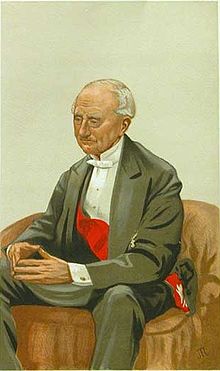Hastings Yelverton
Sir Hastings Yelverton | |
|---|---|
 As depicted byJames TissotinVanity Fair,June 1877. Caption read "Spanish Ironclads" | |
| Birth name | Hastings Reginald Henry |
| Born | 8 March 1808 Kildare,Ireland |
| Died | 24 July 1878(aged 70) Bath,Somerset |
| Allegiance | United Kingdom |
| Service/ | Royal Navy |
| Years of service | 1823–1877 |
| Rank | Admiral |
| Commands | First Naval Lord Mediterranean Fleet Channel Squadron HMSConqueror HMSBrunswick HMSArrogant HMSAigle HMSQueen |
| Battles/wars | Portuguese Civil War Crimean War Cantonal Revolution |
| Awards | Knight Grand Cross of the Order of the Bath |
AdmiralSir Hastings Reginald Yelverton,GCB(bornHastings Reginald Henry;21 March 1808[1]– 24 July 1878) was aRoyal Navyofficer. As a junior officer he took part in a major action against pirates offCandiain June 1826 and was involved in protecting British interests during thePortuguese Civil Warduring the early 1830s. He saw action in theCrimean Waras Captain of one of the two ships that captured a Russianbarquebeneath the batteries atEkenäsin Finland in May 1854. Then in July 1873 he took part in the suppression of theCantonal RevolutioninCartagena.He becameFirst Naval Lordin September 1876 and in that role implemented a series of economies demanded by theDisraeli ministrybut was also involved in ordering the small, cheap and thoroughly unsuccessful ironcladAjax-class battleships.
Early career
[edit]
Born the son of John Joseph Henry (ofStraffan) and Lady Emily Elizabeth FitzGerald (daughter ofWilliam FitzGerald, 2nd Duke of Leinster), Hastings Henry, as he then was, entered theRoyal Navyas a first-class volunteer aboard thefrigateHMSSibyllein theMediterranean Fleetin 1823.[2]He took part in a major action against pirates offCandiain June 1826 and subsequently served as amidshipmanandmatein thebrigHMSColumbine,thefrigateHMSUndauntedand then thebattleshipHMSSt Vincentin home waters.[2]
Promoted lieutenant on 18 December 1830, Henry was posted to thesecond-rateHMSAsia,flagship ofSir William Parker,in September 1831.[3]HMSAsiawas then based atLisbon,protecting British interests during thePortuguese Civil War.[4]He joined thesixth-rateHMSRattlesnakeon theEast Indies Stationin December 1834.[3]Promoted tocommanderon 28 June 1838, he joined thesloopHMSStyxatSheernessin August 1841 and then took command of the sloopDevastationin theMediterranean Fleetin September 1841.[3]He became acting captain of thefirst-rateHMSQueenin the Mediterranean Fleet in May 1842 and acting captain of the fifth-rateHMSAiglealso in the Mediterranean Fleet in April 1843.[3]He was promoted tocaptainon 5 September 1843 and, following his marriage toBarbara Rawdon-Hastings, Marchioness of Hastings(born Barbara Yelverton), assumed the surname of Yelverton on 3 January 1849.[5]
Crimean service
[edit]Yelverton was given command of the steam screw frigateHMSArrogantin October 1853 and saw service in theCrimean War.[2]In May 1854, HMSArrogantand the steam screw frigateHMSHeclacaptured a Russianbarquebeneath the batteries atEkenäsin Finland.[6]Throughout much on 1855, Yelverton withHMSArrogantandHMSMagicienneoperated independently destroyingRuotsinsalmi sea fortressandSvartholm fortress,[7]and was appointed aCompanion of the Order of the Bathfor his services on 5 July 1855.[8]In December 1856, he took command of the second-rateHMSBrunswickand a gunboat flotilla for further operations but the Crimean War ended before he saw any action.[2]He went on to be Captain of the first-rateHMSConquerorin the Mediterranean Fleet in July 1856 andcomptroller-general of the coastguard in July 1859.[3]
Higher command
[edit]
Promotedrear admiralon 30 January 1863,[9]Yelverton became second-in-command of the Mediterranean Station, hoisting his flag in the second-rateHMSRevengein June 1863 and then, from May 1865, in the broadside ironcladHMSCaledonia.[3]
He went on to be Commander-in-Chief of theChannel Squadronin June 1866, and having been promoted tovice admiralon 29 May 1869, he was appointed byHugh Childers,thenFirst Lord of the Admiralty,to a committee to consider the new turret ship design.[2]He was elevated toKnight Commander of the Order of the Bathon 2 June 1869.[10]He was again given command of the Channel Squadron in July 1870 and then becameCommander-in-Chief, Mediterranean Fleet,hoisting his flag in the battleshipHMSLord Warden,in October 1870.[3]
In July 1873, he took part in the suppression of theCantonal RevolutioninCartagena.[2]He was advanced toKnight Grand Cross of the Order of the Bathon 29 May 1875[11]and promoted to fulladmiralon 30 July 1875.[12]
Yelverton, by now suffering fromdeafness,becameFirst Naval Lordin September 1876 afterSir Geoffrey Hornbyrefused the post. In that role Yelverton implemented a series of economies demanded by theDisraeli ministrybut was also involved in ordering the small, cheap and thoroughly unsuccessful ironcladAjax-class battleships.[2]Due to failing health, Yelverton resigned in November 1877 and died at the Grand Pump Hotel inBathon 24 July 1878.[3]
Family
[edit]Yelverton married the widowedBarbara Rawdon-Hastings, Marchioness of Hastings,suo jureBarbara Yelverton, 20th Baroness Grey de Ruthyn(d. 1858) on 9 April 1845; their only child was born shortly thereafter - Hon. Barbara Yelverton (12 January 1849 – 1 October 1924), who married theJohn Yarde-Buller, 2nd Baron Churston.[13]
See also
[edit]- O'Byrne, William Richard (1849)...John Murray– viaWikisource.
References
[edit]- ^Boase, Frederic (1965).Modern English Biography.Frank Cass. p. 2132.
- ^abcdefgAndrew Lambert (September 2004)."Yelverton, Sir Hastings Reginald (1808–1878)".Oxford Dictionary of National Biography.Oxford Dictionary of National Biography(online ed.). Oxford University Press.doi:10.1093/ref:odnb/50203.(Subscription orUK public library membershiprequired.)
- ^abcdefgh"William Loney RN".Retrieved29 December2012.
- ^Laughton, J. K. (2004). "Parker, Sir William, first baronet (1781–1866)". In rev. Andrew Lambert (ed.).Oxford Dictionary of National Biography.Oxford Dictionary of National Biography(online ed.). Oxford University Press.doi:10.1093/ref:odnb/21348.(Subscription orUK public library membershiprequired.)
- ^"No. 20934".The London Gazette.9 January 1849. p. 73.
- ^Napier, Sir Charles (1857)."Chapter VI".The history of the Baltic campaign of 1854.London: Milner and Co.ISBN978-1402185199.
- ^"History of War against Russia".Retrieved11 October2014.
- ^"No. 21743".The London Gazette.10 July 1855. p. 2654.
- ^"No. 22705".The London Gazette.6 February 1863. p. 646.
- ^"No. 23503".The London Gazette.2 June 1869. p. 3179.
- ^"No. 24213".The London Gazette.29 May 1875. p. 2851.
- ^"No. 24234".The London Gazette.6 August 1875. p. 3914.
- ^"thePeerage".Retrieved29 December2012.
Sources
[edit]- William Loney RNCareer History

